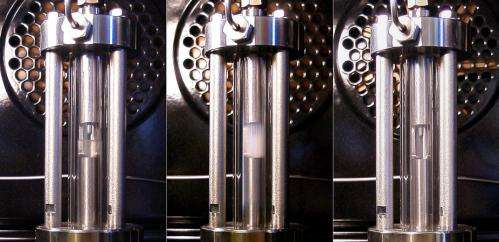Supercritical fluids explained

When we boil a kettle, we observe what scientists call a phase transition: the water changes from being a liquid to a gas as water becomes less dense. One litre of water boils to give about 1,000 litres of steam at atmospheric pressure.
But what if we tried to boil the water at high pressure instead? If we squeezed the water to 1,000 times atmospheric pressure and then tried to boil it?
Until very recently, scientists have been quite clear in their expectations about this. If you squeezed water to 1,000 times atmospheric pressure and then heated it while keeping the pressure on, you would no longer observe boiling as such. The water molecules would whizz around with more energy, and the density would gradually go down, but there would be no boiling. At no point would the water undergo a sudden transition from being a liquid to being a gas. Water (or any other material) under these conditions is called a supercritical fluid.
The conditions of 1,000 atmospheres pressure and 500°C may seem exotic, but to nature this is pretty everyday stuff. Drop a few hundred kilometres into the atmosphere of Uranus, Neptune, Jupiter or Saturn and that is exactly what it is like. On Earth we use supercritical fluids widely in the food, chemical and power industries in everyday processes such as decaffeinating coffee.
Russian endeavour
Historically, our understanding of liquids and supercritical fluids has involved treating them like a gas, but with a few tweaks. However, in the 1930s Russian physicist Yakov Ilyich Frenkel was reflecting on the fact that the density of liquids is much closer to solids than that of gases. Surely then, Frenkel thought, it would be beneficial to understand liquids using some concepts from our understanding of solids?
While liquids and solids are similar in terms of density there are also some major differences – particularly in the amount of disorder. In most solids the atoms occupy regular positions in what physicists call a crystal lattice, a bit like pool balls racked up ready to break or Ferrero Rocher piled high on a plate. In liquids however, the positions of the atoms are nearly random.
Frenkel's work resulted in a book, the Kinetic Theory of Liquids, which was written in difficult conditions at the height of World War II. In it, Frenkel takes then recently developed quantum mechanical ideas to describe solids, and applies them instead to liquids.
At the time, Frenkel's ideas on this subject were ignored by the wider scientific community. Not because they were felt to be wrong, but simply because they were difficult to prove or disprove experimentally. As Frenkel noted in the book, "the realization of high positive pressures and the investigation of…bodies under such pressures has been no easy task". But now there has been a revival of interest in Frenkel's work. Why has it taken so long to explore the consequences of Frenkel's ideas?
When Frenkel wrote Kinetic Theory of Liquids, high-pressure science was in its infancy. Nowadays, however, the situation is quite different. We can now generate 1,000 atmospheres of pressure quite easily and make useful experimental measurements on materials under those conditions.
Drawing lines
Based on these studies, physicists have recently predicted that there may be no such thing as a supercritical fluid after all. Even at arbitrarily high pressure, there will always be some firm dividing line between a gas and a liquid – dubbed the Frenkel Line.
If this prediction is correct then if we were to squeeze water (or any other liquid) to 1,000 times atmospheric pressure and then heat it, we would still be able to see a sudden change between a liquid-like and a gas-like state, with some subtle but important changes in the properties of the material.
The implication here is that if the commonly used supercritical fluids are not what physicists thought them to be, then we might be able to find other interesting properties that could be exploited. After nearly a century of being sure, physicists will now have to rethink how to interpret supercritical fluids.
Source: The Conversation
This story is published courtesy of The Conversation (under Creative Commons-Attribution/No derivatives).
![]()

















